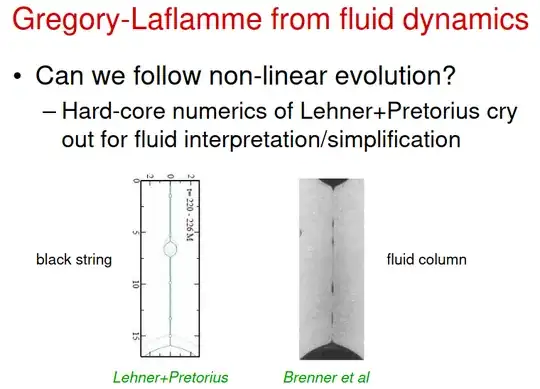Usually (from Hawking's calculations), a black hole has entropy defined by its horizon's area: $$S = \frac{A}{4G}, \tag{1}$$ where $A = 4 \pi r_H^2$ is the area. From thermodynamics: $$dE \equiv dM = T \, dS - p \, dV + \text{other work terms}. \tag{2}$$ Of course, $p = 0$ for a simple Schwarzschild black hole. The question is the following. Considering classical (i.e. non-quantum) general relativity, the temperature of a spacetime is (or should be) $T = 0$. What prevents us in interpreting the temperature of (2) as a surface tension, and substitute $T \, dS \Rightarrow \tau \, dA$? In using $T = 0$, could we write the following? $$dM = \tau \, dA - p \, dV. \tag{3}$$ It seems more natural to me to give a thermodynamical tension to the black hole's event horizon, instead of temperature and entropy. Is there a reason that this interpretation cannot be consistent or cannot be valid?
1 Answers
give a thermodynamical tension to the black hole's event horizon, instead of temperature and entropy. Is there a reason that this interpretation cannot be consistent or cannot be valid?
The second law of thermodynamics (in Planck's formulation) talks about entropy. For black holes we have Hawking's area theorem that could be seen as its generalization. But there is no formulation of second law that talks about surface tension.
Having said that, the analogy between event horizon and fluid surface with a surface tension is indeed compelling, and has been suggested previously. For example, this 1973 paper by L. Smarr (introducing the famous Smarr formula, here is a free pdf) has the following (emphasis mine):
Let us use the mass differential $dM$ to define three physical invariants of the black hole horizon: $$dM = T dA+ \Omega dL+ \Phi dQ,$$ where, following Christodoulou${}^4$ and Bekenstein${}^5$, we say $T=\,$effective surface tension, $\Omega=\,$angular velocity, and $\Phi=\,$electromagnetic potential.
There, references 4 and 5 are to the 1971 and 1972 theses by D. Christodoulou and J. Bekenstein at Princeton.
An example of more recent work along those lines is by Cardoso & Dias, 2006 where an analogy between Plateau–Rayleigh instability of a fluid column fragmenting due to surface tension in a sequence of droplets and Gregory–Laflamme instability of black branes in higher dimensional general relativity, where black strings fragment into a cascade of smaller black holes. Note, that this is about dynamics, not just static equilibrium. In fact, even fully non-linear results on the development of these instabilities supportive of this analogy, for example see the slide from talk by Emparan:
- 17,324
